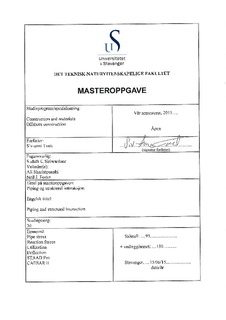| dc.description.abstract | Structural and piping stress analyses are generally conducted separately in most of the situations. A pipe stress analysis is performed based on loads caused by pressure, temperature variations, weight of the pipe (with contents) and blast. The pipes are analysed for several load cases separated into different design types like sustained, expansion and occasional. Established practice in piping design and calculation does not specifically account for structural flexibility. It is assumed that flexibility in the structure is minimal and that the structure is stiff relative to the piping load and in comparison with the piping itself.
The objective of this thesis is to evaluate the conservatism of the established practice. Run different types of sensitivity analysis regarding stiffness of pipe versus stiffness of the supporting structure, i.e pipe-structure interaction.
Limitations for this thesis I have chosen to look at a 20 inch pipe in a simplified system and is supported in ten equally spaced locations of 5m. Three pipe thicknesses are chosen, 4.73mm, 12.70mm and 20.62mm. For calculations of piping stress and restraint support loads Caesar II has been used. Four pipe supports has been modeled using the structural analysis program STAAD.Pro. Pipe support in node 70 and 90 (Caesar ref.) is set as fixed to a concrete deck and pipe support in node 110 and 130 (Caesar ref.) is set as sliding restraints fixed to a steel beam deck.
For design loads the vertical load is the weight of the operating pipe span carried by the supports, the horizontal load will be assumed equal to the friction force. The pipe line and the pipe support are also to be calculated to withstand explosion loads directed from 6 locations.
This model for pipeline and supports will be tested in four cases.
The first case: The established practice where structural and piping stress analyses are run separately.
The second case: Structural and piping stress analyses will be runned combined by implementing the deck deflection calculated in the first case for pipe support in node 110 and 130. The supports for node 70 and 90 are fixed to concrete deck and are assumed to have zero deflection.
The third case: Structural and piping stress analyses will be runned combined by implementing the max acceptable deck deflection (L/200) for pipe support in node 110 and node 130.
The fourth case: In this case the pipe support for node 110 and 130 are set to fail, which means that these two pipe supports will not take any loads from the pipe, only direct blast loads.
These four cases will be compared with respect to changes in pipeline restraint forces, utilization of pipe line stress, pipe line deflection, structural deck deflection, utilization of support beam, displacements in the pipe support.
Figure 1 Model for piping and structural
As a conclusion on the results from this thesis it can be stated that pipe lines with large stiffness can have a very big impact on the pipe supports when included the variation in deck deflection. On the other hand deflection did not seem to have any large impact on the pipe stress other than expansion in this thesis. A flexible pipe line seems to be more beneficial for a pipe support considering the restraint loads, thus leading to a higher utilization and deflection in pipe stress analysis. As I experienced in performing this thesis, interacting piping and structural is very time consuming and as current engineering schedule often means that structural deflection are not available at the time of pipe stress analysis, it will result in additional analysis, where the results might not give a result that makes any significance in the end. As a guide it is important to take in to consideration possible large deck deflections that can occur and have an impact on piping as vell as structural. | nb_NO |
